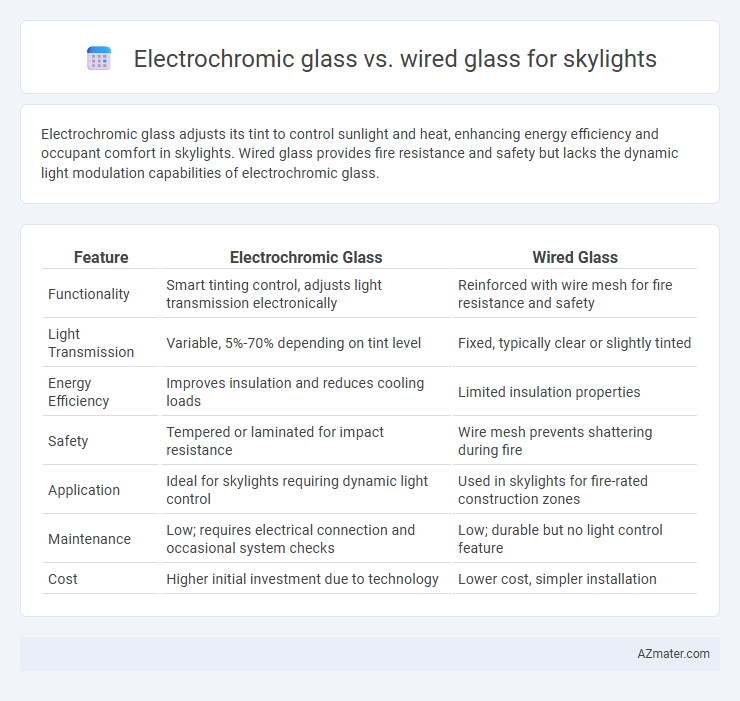Electrochromic glass adjusts its tint to control sunlight and heat, enhancing energy efficiency and occupant comfort in skylights. Wired glass provides fire resistance and safety but lacks the dynamic light modulation capabilities of electrochromic glass.
Table of Comparison
| Feature | Electrochromic Glass | Wired Glass |
|---|---|---|
| Functionality | Smart tinting control, adjusts light transmission electronically | Reinforced with wire mesh for fire resistance and safety |
| Light Transmission | Variable, 5%-70% depending on tint level | Fixed, typically clear or slightly tinted |
| Energy Efficiency | Improves insulation and reduces cooling loads | Limited insulation properties |
| Safety | Tempered or laminated for impact resistance | Wire mesh prevents shattering during fire |
| Application | Ideal for skylights requiring dynamic light control | Used in skylights for fire-rated construction zones |
| Maintenance | Low; requires electrical connection and occasional system checks | Low; durable but no light control feature |
| Cost | Higher initial investment due to technology | Lower cost, simpler installation |
Introduction to Skylight Glass Options
Electrochromic glass for skylights offers dynamic control over light transmission and solar heat, enhancing energy efficiency and occupant comfort through smart tinting technology. Wired glass, commonly used for safety and fire resistance, contains embedded wire mesh that strengthens the glass against impact and prevents shattering. Selecting between electrochromic and wired glass depends on balancing advanced energy-saving features with structural safety requirements in skylight installations.
What is Electrochromic Glass?
Electrochromic glass is a type of smart glass that changes its tint when an electric voltage is applied, allowing for dynamic control of light and heat passing through skylights. It enhances energy efficiency by reducing glare and solar heat gain, unlike wired glass, which is designed primarily for safety and fire resistance without light modulation capabilities. This technology provides customizable shading and privacy options, making electrochromic glass ideal for modern skylight applications seeking both comfort and energy savings.
What is Wired Glass?
Wired glass is a type of safety glass that incorporates a mesh of thin metal wires embedded within the glass to prevent shattering during impact or fire exposure, making it suitable for skylights in commercial and industrial buildings. Unlike electrochromic glass, which offers dynamic light control through electronic tinting, wired glass provides passive safety benefits without altering transparency or light transmission. Its fire-resistant properties and structural reinforcement make wired glass a reliable choice where heat resistance and shatter protection are critical for skylight applications.
Key Differences: Electrochromic vs Wired Glass
Electrochromic glass offers dynamic light control by changing opacity electronically to regulate solar heat and glare, enhancing energy efficiency in skylights. Wired glass, embedded with a wire mesh, primarily provides added safety and fire resistance but lacks light modulation capabilities. The key difference lies in electrochromic glass's ability to adapt transparency in real-time, whereas wired glass remains static, focusing on structural integrity and fire protection.
Light Control and Energy Efficiency Comparison
Electrochromic glass offers dynamic light control by electronically adjusting tint levels to optimize daylight and reduce glare in skylights, enhancing indoor comfort and minimizing reliance on artificial lighting. Wired glass provides basic safety features and structural reinforcement but lacks adjustable light modulation, resulting in less efficient management of solar heat gain and daylight transmission. Electrochromic skylights improve energy efficiency by reducing cooling loads and UV exposure, while wired glass primarily serves fire resistance with limited impact on thermal performance.
Safety and Security Features
Electrochromic glass for skylights offers advanced safety benefits with its ability to control light transmission and reduce glare, enhancing occupant comfort and protection from UV damage. Wired glass provides robust impact resistance and fire-retardant properties, making it ideal for security in high-risk environments while maintaining structural integrity during breakage. Both options improve skylight safety, but electrochromic glass excels in dynamic light control, whereas wired glass prioritizes physical strength and fire safety.
Aesthetic Appeal and Design Flexibility
Electrochromic glass offers superior aesthetic appeal for skylights through its dynamic tinting capabilities, allowing users to control light transmission and privacy without compromising natural views. Wired glass, while providing a distinctive grid pattern and added safety due to embedded wire mesh, limits design flexibility by creating a fixed, industrial look that may not suit modern architectural styles. The ability of electrochromic glass to seamlessly integrate with sleek, minimalist frameworks makes it a preferred choice for contemporary skylight designs emphasizing both form and function.
Cost and Installation Considerations
Electrochromic glass for skylights typically incurs higher upfront costs due to advanced technology and integration with electrical systems, whereas wired glass offers a more budget-friendly option with simpler installation requirements. Installation of electrochromic glass involves electrical wiring and control systems, increasing labor time and complexity compared to the straightforward mounting of wired glass. Maintenance expenses also differ; electrochromic glass may require specialized servicing, while wired glass demands minimal upkeep.
Maintenance and Longevity
Electrochromic glass offers low maintenance with its self-tinting technology reducing dirt buildup and minimizing cleaning frequency, while wired glass often requires more regular inspection due to its embedded wire mesh which can corrode or weaken over time. Longevity of electrochromic glass is typically enhanced by its durable coatings and resistance to UV degradation, ensuring consistent performance for up to 20 years or more. Wired glass provides strong impact resistance but can suffer from reduced lifespan when exposed to environmental stress, leading to potential structural issues and the need for replacement.
Which Skylight Glass is Best for Your Project?
Electrochromic glass offers dynamic light and heat control through smart tinting, reducing energy costs and enhancing comfort in skylight applications. Wired glass provides superior fire resistance and safety due to its embedded mesh, making it ideal for code-compliant skylights in commercial or industrial buildings. Choosing the best skylight glass depends on project priorities such as energy efficiency, safety standards, and aesthetic preferences.

Infographic: Electrochromic glass vs Wired glass for Skylight
 azmater.com
azmater.com